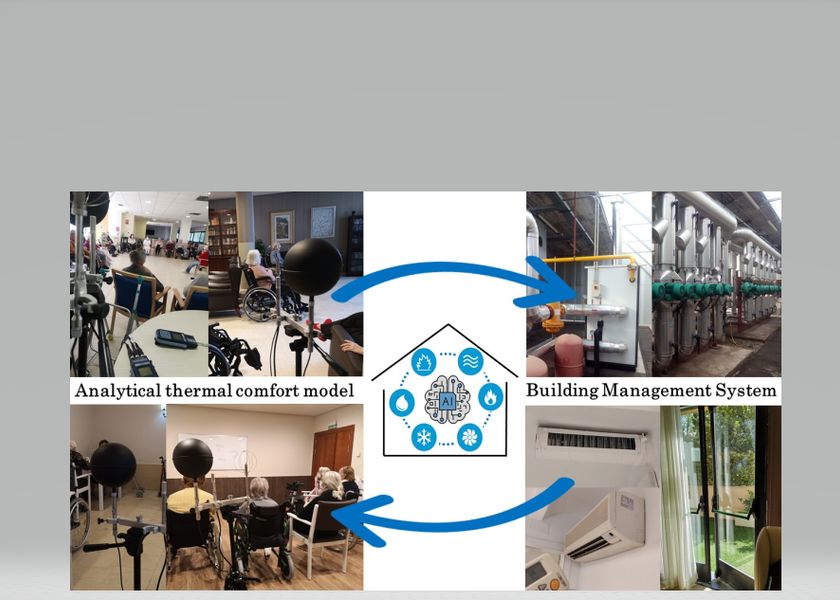Analytical Thermal Comfort Model

Analytical Thermal Comfort Model
Analytical thermal comfort model for buildings occupied by elderly
Buildings account for about 40% of the global energy consumption and contribute over 30% of the CO2 emissions. A significant proportion of the increase in energy use is due to the spread of the HVAC installations in response to the growing demand for better thermal comfort within the built environment. In general, in developed countries HVAC is the largest energy end-use, accounting for about half of the total energy consumption in buildings especially non-domestic buildings.
On the other hand, Europe has experienced substantial increases in life expectancy and thus aging of population. This demographic change has resulted in increasing number of nursing homes. The current Covid-19 virus which is impacting massively in elderly people has manifested the deficiencies of existing nursing homes. These buildings are generally old do not monitor thermal comfort and have a low energy efficiency design.
Considering that older people spend 80% of their time indoors, tend to be frailer than adults, have various health problems and difficulties regulating the body temperature and are vulnerable to extreme thermal environment conditions, their thermal perception is different.
The solution presented here is an analytical model of thermal comfort for those buildings occupied by elderly considering their particular characteristics.
This research was carried out by the Group of Construction Research and Innovation (GRIC), which is a research group of the Department of Project and Construction Engineering, composed of a team of professors and researchers of the Technical University of Catalonia (UPC). The main areas of research in which they are working are improving the energy efficiency of buildings and modelling the built environment.
This thermal comfort model for nursing homes is based on the field survey administered to 5.000 residents from nursing homes in the mediterranean and continental climates. The survey included simultaneous measurements of outdoor and indoor environmental parameters (air temperature (Ta), relative humidity (HR%), mean radiant temperature (Tr) and air velocity (va)) and an assessment of the occupants’ thermal comfort sensations using questionnaires.
This analytical thermal comfort model is based on the activity and clothing levels of occupants, their behavioural adjustments, building type, outdoor temperature and climatic region. It considers that, elderly prefer higher temperatures than adults under particular conditions, elderly have lower thermal sensitivity and adapt most strongly to prevailing indoor temperatures in naturally ventilated rooms.
This an analytical model of thermal comfort is to be integrated into the Building Monitoring System of a building which is a computerised control system installed in buildings that controls and monitors the building’s Heating, Ventilation and Air Conditioning (HVAC) Systems predefining setpoint temperatures, humidity, window opening, ventilation air flow, etc. (Smart Building).
Implementing the analytical thermal comfort model into the BMS will reduce energy consumption and improving the well-being and health of and health of elderly (less probability to have flu or bronchitis in case of cold, contagion of diseases or respiratory difficulties in case of excessive heat, ...).
The analytical model of thermal comfort for elderly can be implemented in whatever building occupied by older adults such as: nursing, homes, day centres, rehabilitation centres, senior community centres, and even new housing options for seniors that in the near future will become a reality such as: active adult communities, independent living communities, assisted living residences, retirement villages, nursing homes or continuing care retirement communities.
The potential interested parties:
a. BMS providers who might integrate the analytical model of thermal comfort in their intelligent systems to provide to their clients (nursing homes) an adaptive and energy efficient HVAC monitoring system.
b. Public sector, through administrations or associations interested not only to offer basic services to the elderly but also to increase the standards of comfort for the residents of their centres in a holistic context and at the same time reduce the operating expenses by adjusting the comfort variables to the real needs of elderly people.
c. Private nursing homes, who are interested in the most comprehensive wellbeing of their residents beyond basic care. The trend of the sector is increasingly specialized and of high added value, which means that these new guidelines can be applied in the medium term in the main players in this market segment.
d. Other public or private companies in care of other buildings for older adults such as: day centres, Rehabilitation centres, Active adult communities, Independent living communities, Assisted living residences, Retirement villages, nursing homes or Continuing care retirement communities.
Your cookie preferences
We use cookies and similar methods to recognize visitors and remember their preferences. To learn more about these methods, including how to disable them, view our cookie policy.


